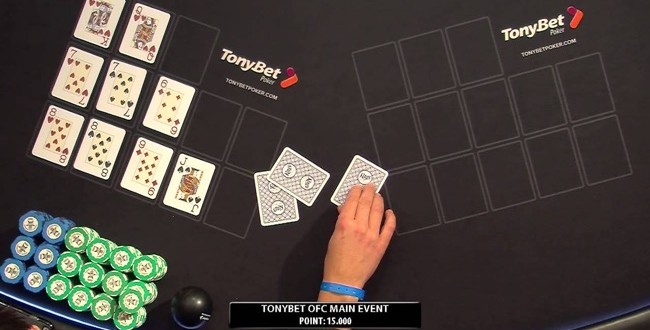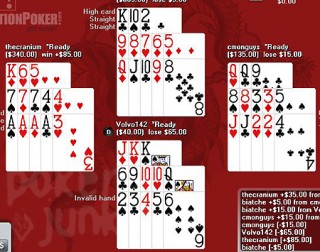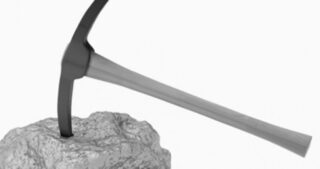Chinese Poker (a.k.a. Pusoy) is a great game for long flights and when waiting around in a hotel lobby or at the pool side. You don't need any chips, you don't need any cash and you don't even need a table.
All you need is a deck of cards (you should never leave home without a deck of cards, anyway), a way to keep score (iPhone notes or Chinese Poker apps are great) and some Chinese Poker strategy basics to keep you from getting wiped out.
The rules of Chinese Poker are pretty simple and you can figure out how to play very quickly; Chinese Poker Strategy, however, is a slightly different story.
Chinese Poker Strategy - A Game You Can Solve
Contrary to normal poker, Chinese Poker is a game that can be "solved". Even if you can't actually solve it mathematically, as an equation, you can use a computer to calculate the mathematically best way to play a hand.
All you need to do is take into account all possible hands that your opponent can hold and find the hand that scores as high as possible on average against all these hands.
This fact may prevent Chinese Poker from becoming really big as an online poker entity, but on a bus trip or train ride most people don't carry their parallel computers along.Who's your opponent?
Chinese Poker Strategy - Adjusting to Your Opponent
The mathematically correct play in Chinese Poker may not always be the best play since it doesn't take into account the style of play of your opponent.
Just as a simple example:
If your opponent systematically neglects the Front Hand, thinking that it's the least important hand, you'll be able to exploit this by moving strength from the Back and Middle hands to the Front as you see fit and score easy points.
Good players often use a scoring system that simulates the mathematically correct play and then adjust for the tendencies of the opponent.
Of course, the exact strategy depends heavily on the scoring system that you're using. A hand that's optimal in a 2-4 system may have to be modified in a game that gives bonus points for special hands, such as trips in Front or Three Straights.
There's no standard scoring system in Chinese Poker.
No Betting in Chinese Poker!
Chinese Poker, or just Chinese, is a poker game with no actual betting involved. That is there's no betting during the play of a hand. Instead, you play for points just as in many other card games like Bridge and Gin Rummy.
However, players will often agree on a monetary value for the points such as 10c or $1 for each point. If you're a really sick gambler - and there are a lot of them out there on the professional circuit - $1,000 a point isn't a stretch at all.
If you want to come out ahead in a Chinese Poker game, regardless of the stakes, try to keep these 5 simple tips in mind to help optimize your play:
1. Avoid Invalid Hands
Avoiding putting down invalid hands may sound evident, and it should be. Nevertheless it's a common mistake and a costly one since it awards each of your opponents a scoop against you.
After all you have to handle 13 cards without making it too obvious to your opponent what you're doing, possibly in a narrow flight seat or on a shaky bus.
Save yourself some huge unnecessary losses by always double-checking that your Back Hand beats your Middle Hand and your Middle Hand beats your Front hand.
2. Scoop or Prevent Scooping
Most popular scoring systems in Chinese Poker award scooping (winning all three hands). As a consequence your primary focus should be to scoop since it's so profitable.
And if you can't scoop yourself, you should prevent others from scooping since it's so costly. For this reason, rather than building three decent hands, you usually want to make one hand that is really strong. This will make it hard for opponents to scoop.
- Try to make a top hand in one position rather than three hands of even strength.
The definition of a top hand depends on the segment. Three-of-a-kind will rarely score in Back but it's definitely a top hand in Front.
Against three players a low full house is about average in Back but very strong in the Middle.
3. How to Play Four Pairs in Chinese Poker
If your hand contains four pairs you can always put the second best pair in Front. Just put the bottom two pairs in Back and the best pair in Middle.
For example, if your four pairs are:
- 22
- 44
- AA
you can put
- 2244x in Back
- AAxxx in Middle
- QQ in front
The pair of queens is good protection against an opponent scooping. With 13 cards you'll have four pairs quite often. In the lack of a better hand, putting the second best pair in Front may be your best option.
4. How to Split Pairs
If you have a straight and two pairs, should you put two pair in the Middle or one of the pairs in the Front?
Most of time it's better to split the pairs since a pair in the Front is quite strong while two pair in the Middle is quite weak.
But if the three remaining cards are good, such as AK9 or AQJ or something like that, you may want to go with these in Front and use the two pair in Middle.
5. Splitting a Full House
Is it better to have a full house in Back or break it up and put the pair in Front?
It depends on the value of the pair and on the rest of your cards. If the full house is 333KK, the full is often not good enough in Back, while KK is very strong in the Front.
(Remember that when comparing full houses, you first compare the trips, so 333KK is beaten by 44422.)
On the contrary, a full house like KKK22 is very strong in Back. Meanwhile, putting 22 in Front wouldn't give you much protection against an opponent scooping, and KKK in Back won't give you many pints on average. You'd probably want to keep this full house in Back.
Then again, if you have a full house like 333KK, a flush in the Middle and AQJ in Front, you may very well choose to keep the boat in Back since your Front is decent as it is.
(Remember that you always need to have a hand in the Middle that beats whatever hand you're thinking of putting in Front.)
Sample Chinese Poker Hands
Here are a few Chinese Poker hands to illustrate some of the strategy points made above.
____________________________________________________
In this hand, I split AAQQ to put a strong QQ in Front.
Player BrulAAp also chose to split his two pair, but it was a measly 4433, which gave a weak pair in Front and a weak pair in the Middle for two lost points. He would have done better by keeping the two pair in the Middle, as we explained above.
(This is also an example of the special hand Three Straights that's part of the Eastern variation of Chinese Poker on the Action Poker network.)
____________________________________________________
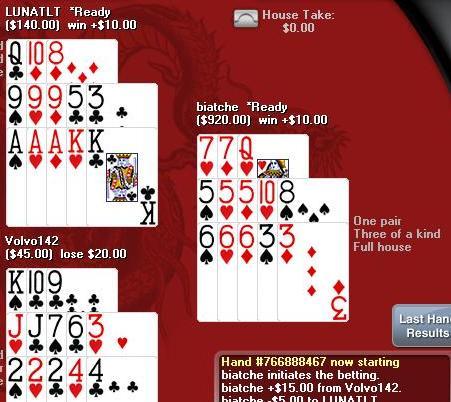
This is a hand where it would have been better to split up the weak Back hand and put a pair in the Front, even if it's a puny pair. The low full house in Back gets beaten two ways.
____________________________________________________
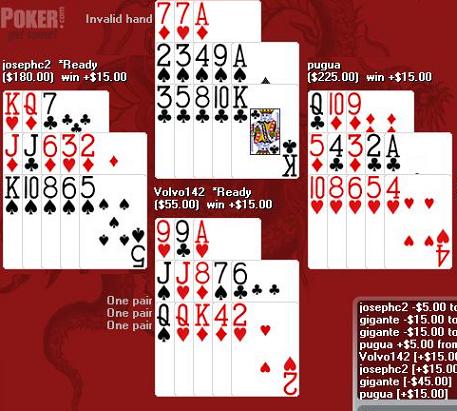
A pair in Front can be surprisingly strong even in a four-player game. In this hand, a pair of nines in the Front wins three ways. Meanwhile, two pair in the Middle would have been a net loser here.
